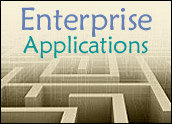
How many times have you read a book and realized that you can’t recall a major character? Or, maybe you were left wondering how an important plot came to pass. The average novel contains 50,000 lines of text. Now, imagine a multimillion-line novel written by a team of authors over the course of decades that was repeatedly rewritten to the point that entire chapters were no longer relevant to the plot. That is the typical application portfolio of today.
Application portfolios control your most central business processes. However, over time, they tend to become more complex, less manageable and less aligned with your enterprise goals. In fact, many core business operations are likely automated by applications that can’t be efficiently adapted to support real-world business requirements.
However, how can you allocate your scarce resources to best support your business if you have only limited understanding of the contents of your application portfolio? This article discusses how application portfolio management (APM) can address this challenge, and describes the key attributes of an APM solution.
How Does APM Help?
APM solutions allow organizations to identify, prioritize and act on initiatives that realign the application portfolio with business goals. They do so by trending technical and business metrics regarding enterprise applications’ value, cost and risk. This information is then presented back to the right level within your organization to facilitate decision-making and implementation.
Your preferred APM solution should automate the collection of technical metrics regarding the health and maintainability of enterprise applications. To ensure that information is always current, the APM solution should include a facility to refresh these metrics on a rapid, ongoing basis. It should also be able to assess a diverse range of application environments. After all, the typical application portfolio contains everything from Cobol and Assembler to Visual Basic and Java.
This data can be supplemented by business-level metrics regarding the value of these applications for the enterprise. By surveying system stakeholders, an APM solution can measure where weaknesses and value exist. For instance, surveys could be geared to determine systems that are underused because of a lack of alignment with business requirements. Your APM solution should include a surveying mechanism that allows users to readily adapt and deploy questionnaires specific to your organization in order to quickly consolidate information from stakeholders. Generally, a browser-based solution to collecting this data is most logical.
Successful APM solutions then focus on presenting the right level of information back to the right user in the organization. Trended metrics in dashboard form allow each level in the organization to identify and prioritize modernization activities. By centralizing technical and business insights into your processes and applications, your organization can make better decisions about where to invest scarce IT resources — the goal of which is to reduce investments in non-core, high-risk, high-cost or low-value applications so that resources can be devoted to activities that deliver real business value.
So, APM will help your organization to reinvest in what is core to your business. However, what are the attributes of a successful APM solution? There are multiple commercially available solutions on the market to automate your APM initiative. The solution you choose should have an immediate impact that can build momentum, it should be highly customizable to your organization’s specific needs and it should provide the basis for the implementation of your decisions.
Immediate Impact
Some APM solutions can put CIOs in an awkward catch-22. Organizations must determine where inefficiencies and misalignments exist in order to implement corrections. However, “boil-the-ocean” APM solutions can lead to significant expenditures and distractions in the short term. Spending more to save more can be a difficult business case to make. An optimal approach is to uncover applications and business processes that can be swiftly rationalized from the portfolio. This allows the organization to quickly demonstrate business value and reinvest a portion of the savings in the identification and implementation of additional modernization initiatives.
Boil-the-ocean solutions suggest integrating data collected from ERP (enterprise resource planning), HR, SCM (supply chain management) and a wide variety of other systems. These metrics will provide a clear picture of where to rationalize applications and rededicate resources. In fact, this information is of great value as your APM approach matures. However, should you necessarily begin with a solution that requires this integration? For most organizations, the 80/20 rule can be applied, especially in the short term.
Organizations should investigate APM solutions that provide answers quickly, allowing CIOs to build a track record of savings through rationalization and modernization activities. This success can then be built on, customizing the information that is collected in order to refine your decision-making.
Customize Approach
Your organization’s business priorities shift over time as market pressures and opportunities arise. This has a natural impact on where the focus of IT will be placed. For instance, cost reduction may start as your principal goal. This may give way to a focus on consolidation of business processes following a merger.
As a result, you will want an APM solution that can adapt to support these shifts. This is achieved in part by adjusting which kinds of data are collected. For instance, you may want to integrate your APM approach with data from HR systems in order to identify costly, labor-intensive processes. This integration with your APM solution should be straightforward to ensure that the focus is on making and acting on better decisions, and not simply trying to build the best mousetrap.
While generic questionnaires form a good basis for collecting business-level insights, you will want to customize the data you collect. Good IT governance requires that you can focus on issues that are specific to your organization and market. For instance, industry-specific regulatory compliance issues or security questions may be addressed in the questionnaires you develop. This requires that your APM solution allow you to quickly adjust your questionnaires and distribute them to the correct audience for fulfillment.
Additionally, you may wish to adapt the weightings given to certain measurements. For instance, you may decide that measurements of the risk associated with a “burning” platform may be important due to emerging regulatory compliance issues like Basel II. Your APM solution should be flexible enough to allow for these ongoing customizations as needed.
Act on Decisions
Identifying and prioritizing activities that can yield savings or flexibility is without any real value unless you act on the results. That means if you decide to outsource a set of applications that are not core to your business, then you can quickly act on that decision. Or, if you uncover tactical inefficiencies in your applications that you can quickly act to eliminate these problems. Or, maybe you have uncovered highly reusable business processes that are core to your operations. Acting to service-enable these processes may be a core initiative.
The challenge, however, is that each of these activities requires detailed insights into the application code itself. To outsource an application requires understanding its boundaries to avoid unintended impacts. To service-enable a process requires isolating it and determining if there are architectural hurdles that could impact its usefulness. However, having to recollect application intelligence to support these activities slows the implementation of the rationalization and modernization actions. This can diminish the impact of the cost-saving goals of your APM initiative.
A better approach is to combine deep analysis with high-level abstractions of the data. Executives should be able to view top-line metrics that identify opportunities for improving the application portfolio. The CIO can pass his or her priorities to the next level in the organization. The application manager could then zoom in on root causes of problems, or on information that would allow for the priority to be implemented. Each level, from CIO through to development professional, should be able to drill down to the appropriate level of detail in order to identify, prioritize and act on their decisions. As a result, your preferred solution for APM should collect and present both high-level and detailed insights into your application portfolio.
An Action-Oriented Solution
APM offers an approach to bring your application portfolio in-line with your business requirements. However, organizations should be careful when selecting an APM solution. They should look for solutions that create immediate value by quickly centralizing the right mix of business and technical metrics.
The ideal solution should enable decisions to be made based on this data and in the face of changing business circumstances by presenting dashboards in an accessible and customizable format. Finally, the APM solution should be “action-oriented” to ensure that the identified modernization activities can be executed in practice.
Charles Dickerson is senior vice president at Relativity Technologies, a provider of enterprise application modernization solutions. He has 20 years of product marketing and product management experience in the software industry.






































Social Media
See all Social Media